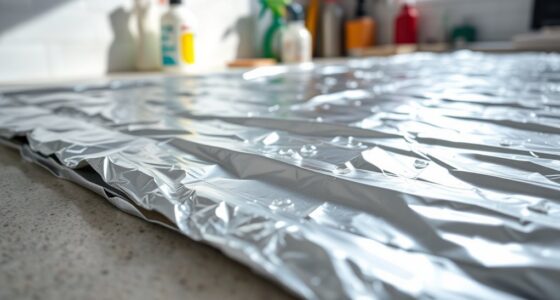To find your ideal board volume, use an accurate volume calculator that considers your body weight, height, skill level, and riding style. This tool helps guarantee your snowboard supports you properly, offering better control, stability, and safety across different terrains. Matching your weight with the correct volume prevents sluggishness or excess float, making your rides more enjoyable. Keep exploring to discover how to fine-tune your setup for the best snowboarding experience.
Key Takeaways
- Use a reliable volume calculator that considers your weight, height, skill level, and riding style for accurate recommendations.
- Input your body weight precisely to receive a volume range optimized for floatation, control, and safety.
- Consider board material and construction details as they influence the ideal volume for your weight and skill.
- Match the recommended volume range with your physical attributes to prevent sluggishness or excessive floatation.
- Verify the calculator’s guidance aligns with your riding preferences and terrain for a tailored snowboarding experience.

Determining the right board volume is essential for optimizing your snowboarding experience, whether you’re a beginner or an experienced rider. The volume of your snowboard influences how it responds to your movements and how easy it is to control, especially when traversing different terrains. To find the ideal board volume, considering your body weight is crucial, as it directly affects floatation, stability, and overall comfort on the snow. When selecting a snowboard, you’ll want to look at the volume and compare it to your weight to guarantee you get a ride that’s neither too floaty nor too sluggish. Using a volume calculator designed for snowboards can help you make an informed decision, matching your weight to the recommended board volume range. Additionally, understanding the different air purifiers and their technologies can help you create a healthier environment while resting or preparing for your next run. Your choice of board material also plays a significant role in determining the appropriate volume. Different materials—such as wood, foam, or composite layers—affect the board’s weight, flexibility, and durability. A lightweight material might allow for a slightly smaller volume, making the board more responsive, while a sturdier material could require a different volume to maintain stability. Knowing the board material helps you understand how the board will perform under your weight and riding style. Furthermore, safety precautions should never be overlooked when choosing a board. Opting for the right volume means less risk of falls or injuries, as a well-fitted board provides better control and reduces strain on your legs and knees. Always verify that the board size aligns with your skill level and physical attributes, and don’t forget to double-check the sizing with a reliable volume calculator to prevent mismatched gear.
When you’re using the calculator, input your body weight accurately to get precise recommendations. Remember that riding on a board with the correct volume improves not just your performance but also your safety. Too large a board can make turning difficult, while too small a board might not support your weight properly, increasing the risk of accidents. Keep in mind that safety precautions extend beyond just size; wearing proper gear, understanding snow conditions, and practicing good riding habits are equally essential. By matching your body weight with the right board volume, considering the board material, and adhering to safety precautions, you’ll set yourself up for a smoother, more enjoyable snowboarding experience. This approach helps you ride confidently, knowing you have the right gear tailored to your needs, ultimately enhancing your control, comfort, and safety on the slopes.
Frequently Asked Questions
Can I Adjust My Board Volume for Different Surfing Conditions?
You can definitely adjust your board volume for different surfing conditions. Consider how board flexibility and surfboard material affect performance; a more flexible board suits choppy waves, while stiffer ones work better in clean, powerful surf. Changing your board volume slightly also helps, making your board more responsive or stable as needed. Always match your board’s flexibility and material to the specific conditions for ideal performance.
How Does Age Affect the Ideal Board Volume for My Weight?
Age factors influence your ideal board volume because as you get older, your strength and agility may decrease, requiring a slight weight adjustment in your board choice. Younger surfers might handle smaller, more maneuverable boards, while older surfers benefit from increased volume for stability and ease of paddling. Consider your current fitness level and comfort, then adjust your board volume accordingly to maintain performance and enjoyment in the water.
Is a Higher Volume Board Better for Beginners?
Many believe that a higher volume board is always better for beginners, but that’s a common board volume misconception. In reality, beginner board preferences vary based on skill level and comfort. A board with too much volume can be difficult to control, while one with too little might be unstable. Focus on finding a balance that suits your ability, ensuring easier paddling and better progress without solely relying on higher volume.
How Often Should I Re-Calculate My Ideal Board Volume?
While it’s tempting to think you need constant adjustments, you should primarily focus on your comfort and progress. Re-calculating your ideal board volume isn’t needed every session; instead, consider periodic frequency updates based on how your skills and strength develop. Tracking progress over time helps you know when it’s time to reassess, ensuring your board size continues to match your evolving abilities without overthinking every change.
Does Body Composition Influence the Ideal Board Volume?
Your body composition, including body fat and muscle mass, definitely influences your ideal board volume. Higher muscle mass can handle more volume because muscles support greater workload, while higher body fat might require adjustments to prevent overtraining. You should regularly re-calculate your ideal board volume as your body composition changes. Paying attention to how your body responds helps optimize your training, ensuring you stay safe and make progress efficiently.
Conclusion
Now that you’ve got the perfect board volume at your fingertips, you’re ready to ride the waves of confidence and control. Think of this calculator as your trusty compass, guiding you through the surf with ease. With the right volume, you’ll glide smoothly like a dolphin dancing through the ocean. Trust your instincts, embrace the ride, and let your board be the wings that lift you high—your adventure on the water is just a splash away!










